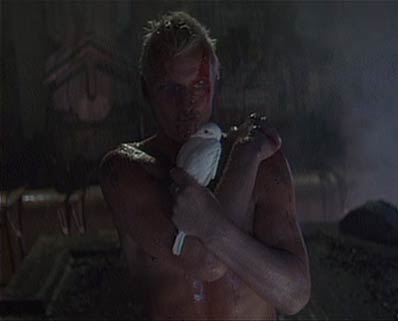Year: 1982
Directed by: Ridley Scott
Written by: Philip K. Dick (Novel), Hampton Fancher & David Peoples
IMDB Reference
Degree of Cyberpunk Visuals: Very High
Correlation to Cyberpunk Themes: Very High
Key Cast Members:
Rick Deckard: Harrison Ford
Roy Batty: Rutger Hauer
Rachael: Sean Young
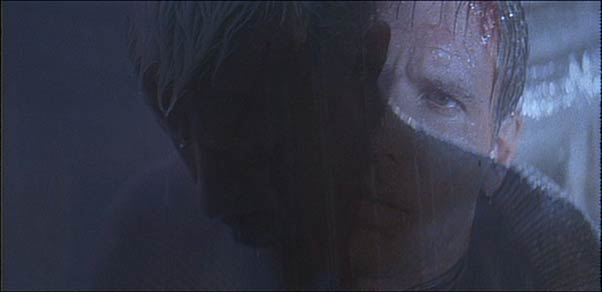
I’ve seen things you people wouldn’t believe. Attack ships on fire off the shoulder of Orion. I watched C-beams glitter in the dark near the Tannhauser gate. All those moments will be lost in time, like tears in rain. Time to die…
Overview: If you read a lot of the reviews from others about movies on this site, you’ll find that over half of them reference Blade Runner in some way, other in the visuals or issues discussed. Along with Gibson’s Neuromancer, Blade Runner did more to establish cyberpunk as a genre. The fact that Blade Runner came two years prior to Neuromancer is rather interesting. Truly, this film set the standard for the near-future film noirs sub-genre we call cyberpunk.
Not too dissimilar to the wrath that greeted Metropolis’ release, Blade Runner was not an instant hit. Instead it grew from being critically panned to a cult classic, to now, where its well on its way to being considered a timeless classic.
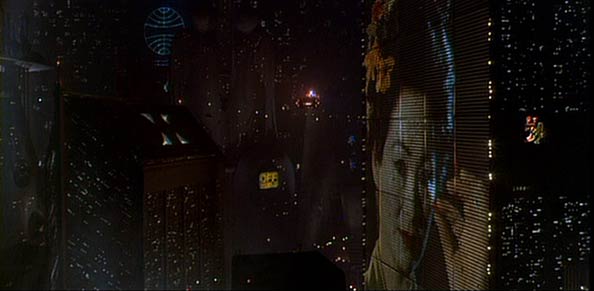
Commerce is our goal here at Tyrell. More human than human is our motto
The Visuals: The visuals in Blade Runner are simply stunning. We see corporate pharaohs ruling a society containing manufactured slaves from their Egyptian style pyramids, while we see rot and decay on the streets below. Noir-style beige and blacks dominate the screen, but are often supplanted by shocking neons. In Blade Runner, we see and Earth in ruin - a place that people are eager to leave. Only the poor and problematic are left on this rain-soaked dystopian planet that has been raped of any semblance of natural existence. The Earth is now almost completely devoid of trees and animals, which are now replaced with artificial ones for the pleasure of mankind.
The Story: Technology and corporate power are clearly the cause for this downfall. Genetic engineering has run rampant, and is combined with advanced organic computing technologies. It is in this world that we find a cast of flawed characters. Nobody is pure, nobody pristine. They are all a product of the environment they live in.
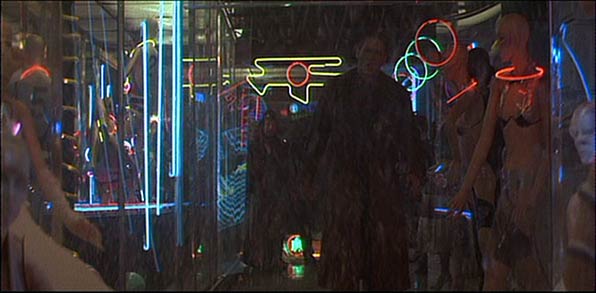
Replicants are like any other machine - they’re either a benefit or a hazard. If they’re a benefit, it’s not my problem.
To augment humanity’s needs and desires, replicants, or genetically engineered humans imbued with artificial intelligence have been developed. They serve many important roles including protection, pleasure slaves, and hard labor for the most dangerous environments. While replicants start out as rather straightforward and useful machines, over time, they start to develop awareness - their own personality, and eventually, free will and a desire for self-preservation. Because they are defined as property, Replicants are given a 4-year lifespan, which is enforced upon inception, and is irreversible.
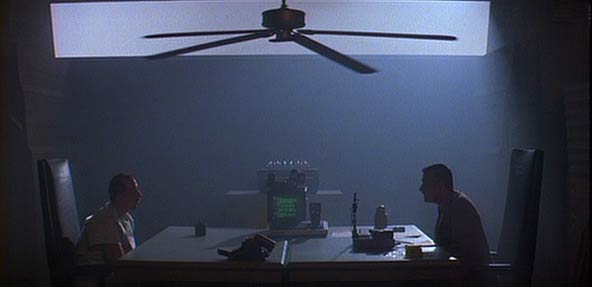
My mother? Let me tell you about my mother!
It is in this world that we encounter Deckard (Harrison Ford), a Blade Runner. Blade Runners are cops who hunt down Replicants. At the beginning of the movie, we find that Deckard has supposedly retired from the business.I say supposedly here, because if he is a replicant, then really, he has been imbued with false memories as well, and in fact has never been a blade runner prior to this. Really, he is just filling in as a laborer fulfilling another job that is too dangerous for humans.
Deckard is brought back in to "retire" 4 runaway "skin jobs" (replicants) who have murdered humans off-world and have escaped to Earth. Apparently, they seem to be interested in coming back to their creators - the Tyrell corporation. The story expands from there, and truly touches on some wonderful questions concerning ethical dilemmas that most certainly will arise in the future.
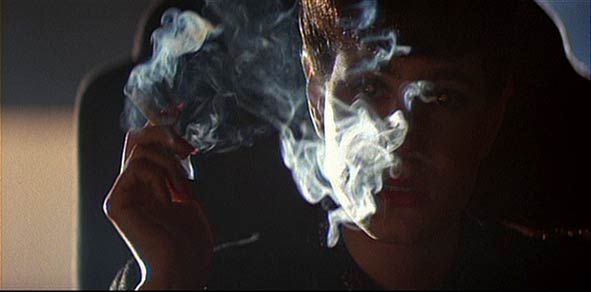
Are these questions testing whether I’m a replicant or a lesbian, Mr. Deckard?
I’m not in the business. I AM the business… Deckard encounters Rachael (played wonderfully by Sean Young), a replicant who during the movie discovers her true nature. Blade Runner does a masterful job of exploring the questions and emotions surrounding this. We see Rachael’s theme echoed in Natural City, Armitage, Thirteenth Floor, Ghost in the Shell, Serial Experiments Lain, Malice@Doll, the Animatrix, I, Robot, and others. This question about what degree artificial life forms are human is a central theme of the cyberpunk genre.
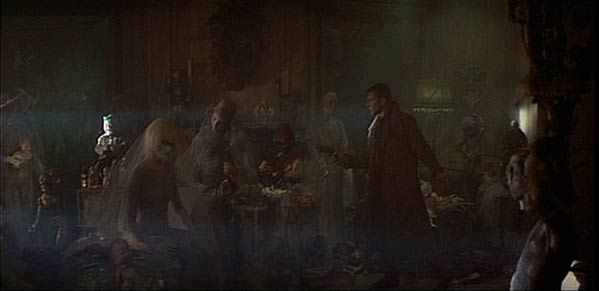
What is Human? While other movies have been terrific in exploring this, Blade Runner still sits at the top of the list, both for Racheal, and for Roy Batty, the leader of the renegade replicants. Roy’s monologue near the end (see the quote at the top), which was supposedly adlibbed by Rutger Hauer, captures in a single moment the ethical dilemma with creating sentient life. If they have freewill, can they really be considered property? And if they aren’t property, what are they, exactly?
Blade Runner uses mannequins and toys as its set piece for representing this dilemma. In Blade Runner, corporations create these glorified toys - moving mannequins if you will, to meet the needs of society, yet while the toys themselves are clearly a product of the society just like all the other noir characters, are they truly nothing more? And if we do consider them to be on par with humans, what obligations do they have to their creators, who invested time and money in their creation?
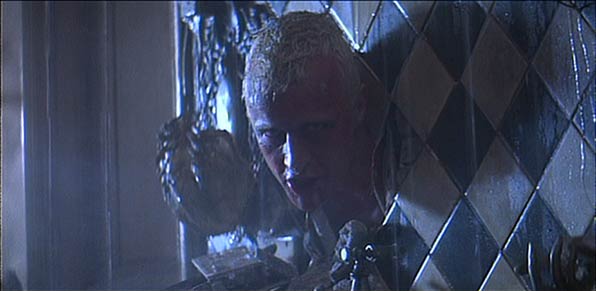
The light that burns twice as bright burns half as long - and you have burned so very, very brightly, Roy.
The Bottom Line: On top of all this philosophical questioning, we get some great noir-detective-like action and suspense. Roy Batty is truly a badass. Deckard’s pursuit of him is a very fun engagement, as is the climax. Its flat out terrific. The pacing is wonderful, the visuals are astounding, and the story is enthralling. By now I’m guessing most have seen this cinematic masterpiece, but if not, you are truly in for feast!
Page 2 - More Screen Captures–>>
~See movies similar to this one~
Tags: cyberpunk movie review
Year: 1988
Directed by: Shinya Tsukamoto
Written by: Shinya Tsukamoto
IMDB Reference
Degree of Cyberpunk Visuals: Very High
Correlation to Cyberpunk Themes: Very High
Rating: 10 out of 10
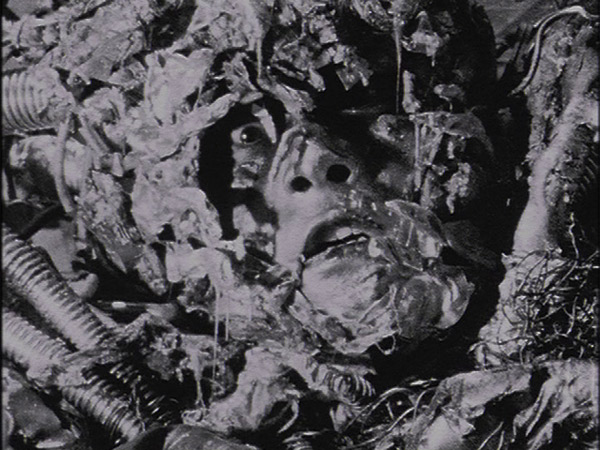
Overview: For another movie that taps out the weird shitometer scale, and the pinnacle of Japanese cyberpunk flicks, Tetsuo is simply terrific! I must warn you that this movie is NOT for everyone. We get a bevy of disturbing images, including extreme body manipulation, anal rape of a guy by a mechanically "enhanced" female, rape in the reverse by a man with a literal "power tool," and truly the most bizarre set of images one can imagine. But in all this, there are some truly interesting messages that emerge. Unlike other Japanese Cyberpunk films such as Rubber’s Lover, which is more of a one track film (extreme situations to prompt greater than human abilities), Testsuo provides a wonderful commentary on the direction of mankind.
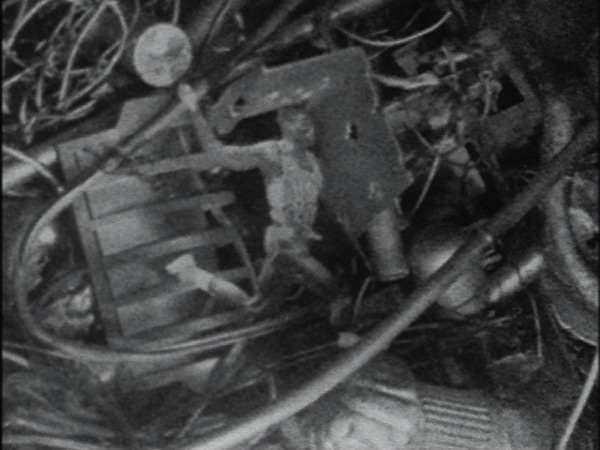
This is one of the best opening symbols for any movie I can remember. It sums up Tsukamoto’s message perfectly!
Tetsuo’s Message: While Tetsuo is a really bizarre, low budget, surrealist underground Japanese cyberpunk movie, it has a number of interesting themes running through it. On a societal level, Tetsuo explores how man’s technological dash to the future has resulted in an acute fear of technology, and that its ever encroaching progress is destroying our humanity. This is symbolically represented by a runner surrounded by scrap metal, and then later, a man in running gear who’s slowly being taken over by machinery when competing with another machine man.
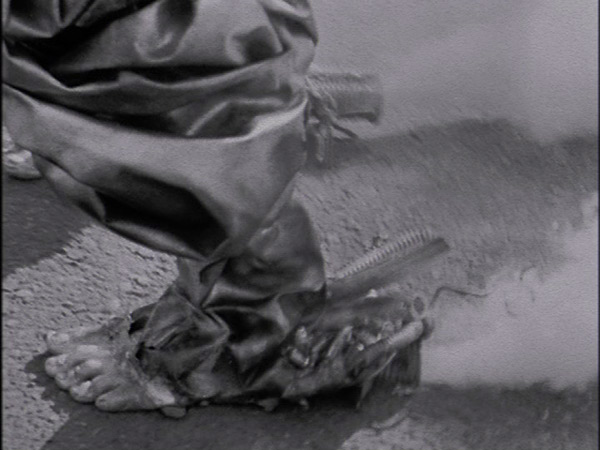
The clear message at the end is that by constantly competing with one another in our strive for perfection in an orderly society, we are destroying humanity at its core. Technology is our tool of choice for this destructive competition. The shot of the augmented foot above really captures this well, as does the race scene below.
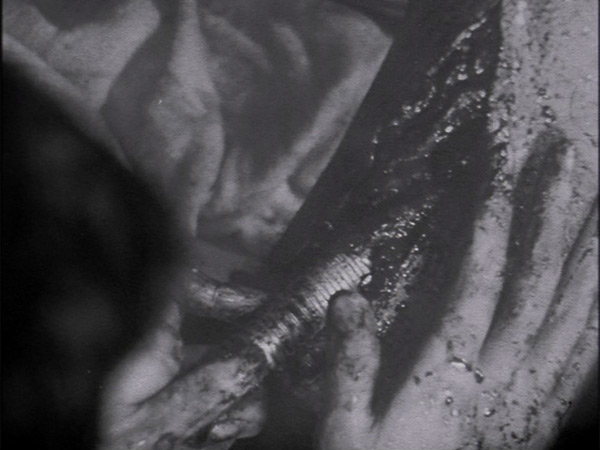
I can’t convey how truly disgusting this scene comes across
On a personal level, Tetsuo explores how guilt and repression can turn people into virtual "monsters." In this, we see an instance where an accidental car crash makes someone completely lose all sense of humanity and boundaries. This seems to fit with Asian cultures in that they are usually very reserved, but when they "cross" that line, the level of anger and craziness almost doesn’t have a limiter.
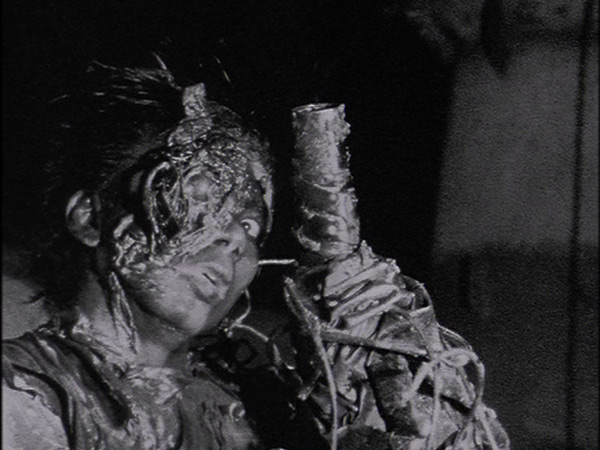
In combining this with the societal thought, Tetsuo posits that we are using technology as a crutch to cover up our own frailties, but that in doing so, we only serve to subvert our humanity. When this subversion is released, it becomes a perversion of immense proportions. In this sense, Tetsuo truly stretches the cyberpunk notion of "no boundaries" to its fullest.
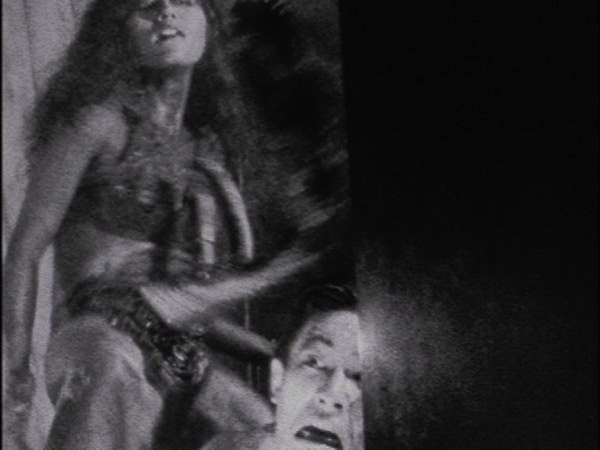
Yes, she’s about to do what you "think" she’s planning to do with that thing!"
The Bottom Line: Tetsuo is a great example of what a low-budget scifi film can accomplish. I thought the cinematography is absolutely brilliant. We get cool stop-motion animation, incredibly interesting shadows and film angles, and wonderful use of different shot textures. The industrial sound track furthers the truly bizarre mood. Truly, I can’t say enough of how impressed I am by this film. Again, Tetsuo is DEFINITELY not for everyone, but it certainly belongs in the top 10 best cyberpunk films ever made!
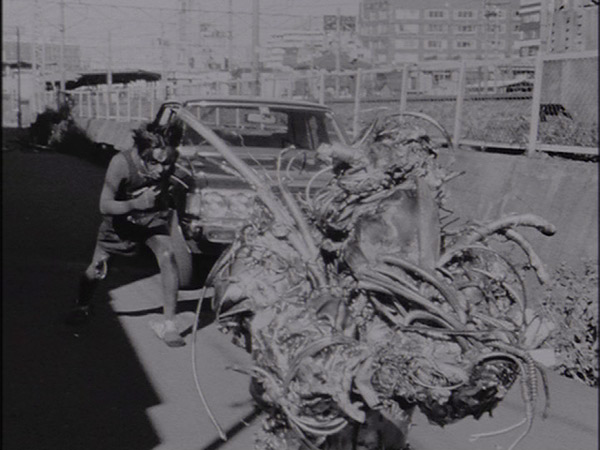
Screen Captures - ADULTS ONLY: I do have a second page of screen captures, but I MUST warn you - these are VERY graphic. They show one of the most intense sex and violence scenes every put on film. If you want to get a sense of he the extent that Japanese cyberpunk fullfills its “no boundaries” approach, take a look. But this page is intended for adults - and truly, only a few select few of those. Don’t look if you’re not comfortable with watching these things.
Tetsuo Page 2: Screen Caps - ADULTS ONLY–>>
Year: 2004
Directed by: Mamoru Oshii
Written by: Shirow Masamune (Comic), Mamoru Oshii (Screenplay)
IMDB Reference
Degree of Cyberpunk Visuals: Very High
Correlation to Cyberpunk Themes: Very High
Overview: If you’re looking for the best instance of awesome 2D-3D anime with an incredible philosophically laden story, Ghost in the Shell: Innocence is the hands down winner. While I still like Wonderful Days more on pure cinematography, it doesn’t hold a candle on either the story or the philosophy. Oshii is truly a master at providing an incredibly intricate, fully researched message about the direction of humanity in a wonderful anime package. Make no mistake - Oshii is fully up on co-evolution theory (the co-evolution of man and his tools) and has something very interesting to add to the discussion. And while it has all of this, GITS:2 does suffer overtly and purposefully from the absence of its star character - Motoko.
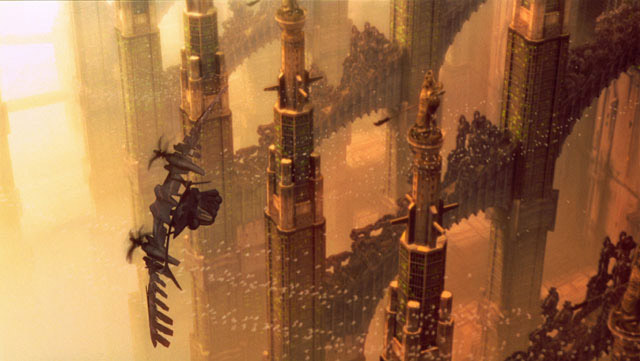
Major Motoko, the main character from the first Ghost in the Shell movie (which might still make an appearance here…) is no longer here, and the rest of the cast has to pick up the pieces and move on. Bateau (Ôtsuk), major motoko’s partner from the first movie, and a cyborg detective for the anti-terrorist unit Public Security Section 9, investigates the case of a female robot - one created solely for sexual pleasure - who slaughtered her owner. Togusa, the mostly human detective that Motoko found in Ghost 1 is assigned as Bateau’s partner. The plot thickens as the movie progresses, and the two are sent to a number of incredibly cyberpunk looking locations to uncover the truth.
Overall, this movie has the feeling of a cast trying to cope when the major star has left. Similar to the Borg Encounter when Picard is removed, or maybe some of the first star trek series when Captain Kirk is lost somewhere doing green chicks, Motoko’s disappearance dominates a most of the back story. We get to see almost a character study of Bateau, a mostly cyborg being who has suffered the loss of the closest person alive to him struggle to maintain meaning in his life
and Togusa failing to live up to Bateau’s expectations as a partner. While the characters are able to work fine within the plot, the movie suffers from the lack of both sex appeal and the lack of a truly dominant character.
Similar to other Oshii films, there are instances where the plot gets put on hold to allow the philosophy to explored. This is a different sort of pacing (again copied by the matrix) which some like and others find pretentious (I like it!). The philosophy breaks are interesting, but only get fully connected at the end. Additionally, the plot is twisting enough and only clarified in the end that a second viewing would aid in comprehension.
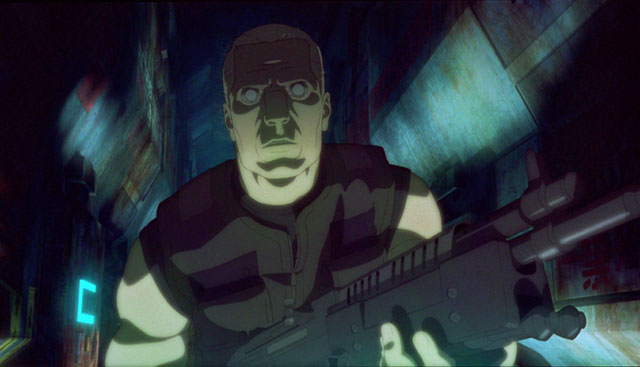
Even if you don’t like the metaphysical mumbo-jumbo or strange pacing, Ghost 2 should be seen as mandatory viewing for its truly mind blowing merging of computer imagery and hand drawn animation artistry. This is cyberpunk at its finest! Truly, Neuromancer’s William Gibson would be floored with the continually awe-inspiring scenery that’s intermixed with the grittiest of settings. I lost count of the number of sets I would have loved to freeze and place on my wall. From the creation of robots complete with fiber optic circuitry and positronic brains, to the dingy alleys of the underworld, the vast expanses of the futuristic building-scapes, this movie employs every color palette in the most effective manner imaginable. Often, you almost stop paying attention to the subtitles to just take in the scene in all its heavenly glory.
On top of this, we get trademark moments of Oshii pacing. Oshii is fully content to leave the dialogue aside for a while and let the mood develop from the visuals and sound. Very few movies do this effectively - Avalon and GITS:2 certainly come to the top of the list. In short, the pacing makes GITS:2 a fully immersive experience in a way that visuals alone couldn’t do.
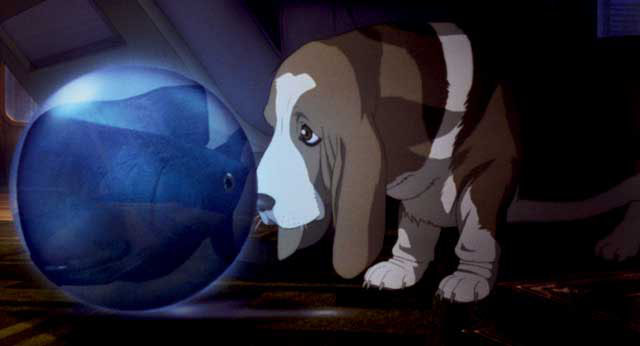
GITS 2 Philosophy: In looking at the philosophy, the first Ghost was dominated by a discussion of what it means to be human and being alive. It culminated in the creation of a new species - the merging of a sentient program called the puppet master with Motoko, an alive human complete with a soul (ghost). Without knowing the details of Ghost 2, one would have expected in seeing the first movie that Oshii would have explored this vast new experience in Ghost 2, Yet this was not to be, as instead the story takes a very different perspective to the ideas covered in the first movie. Innocence is really tracing the idea that what we "see" isn’t at all real, and that reality as a concept needs significant revision. This is done in a variety of ways through mirror analogies, VR segments and discussions of whether there is a difference between artificial life and real life. In this sense, GITS2 is far more the philosophical sequel to Avalon.
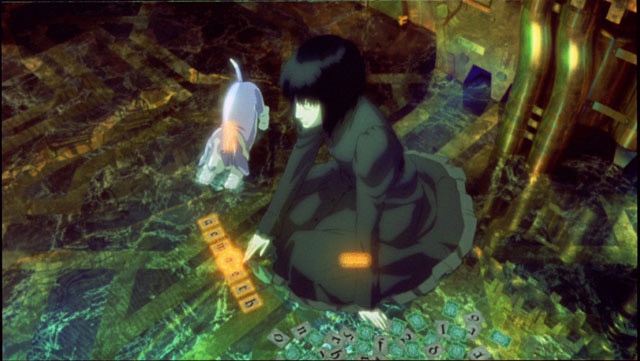
Ghost 2 almost turns the perspective from Ghost one on its head and looks at what it means to be a sentient program and how even humans seeking to become fully cyborg struggle to attain this plateau of ever increasing sensory perception and understanding. Taking Decarte’s notion ("I think, therefore, I am") that sentient life does not require a ghost, Ghost 2 explores the notion that a sentient program or robot (called a "doll") might NOT want to have a ghost, and looks at what happens when ghosts are foisted on dolls. Ideas taken for granted in the real world, like the demarcation between life and death get blended and rendered almost meaningless.
On Dolls: Let’s go into a discussion of dolls for a moment: On one hand, dolls in our terms are purely fake, but in the eyes of a child, are actually "real" in the sense that they are assigned virtual persona and as an object and affect the behavior of the child. In effect, the notion of the child’s mind being constrained to her head is challenged - the child’s mind functions "virtually" in the doll. This notion of a doll is also examined in the sense that it contains our greatest fears - that all we are is a "shell" without something actually unique inside that makes us special. In making a cyborg "doll" that mimics a human - GITS2 poses that we are creating a human-looking shell that is sentient in the Descartes sense, but is not complete. Even worse, when given a facsimile of a ghost, we are doing real harm to the doll as the doll is now neither a stable sentient robot nor a human, but a bastardized thing in-between.
In total, there is this ongoing discussion of three types of "ultimate" life forms: God, Dolls, and animals. They all embody the notion of innocence. God (in this sense, almost synonymous with Major Motoko’s new form) is all knowing so basic human frailties no longer affect her. Needs and desires that humans have are non-existent for God. Dolls, and in cyborg version of dolls - sentient robots, are also perfect in that they can think but don’t fall prey to human inadequacies. Finally, Oshii argues animals such as dogs are innocent. Their joys in life are simple ones - Batou’s dog scenes also serve to demonstrate that which is still "human" about Batou - everything else in his life has been rendered meaningless. In this sense, interestingly the dog takes on the same roll as a doll does with a child - This shows Batou’s mind expressing its "virtual" humanity externally.
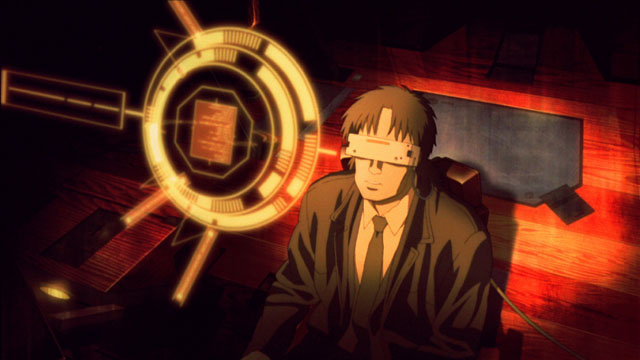
Throughout the movie are instances of humanity’s self-gratification, extreme self-importance and the consequences of over-indulgence. From the enormous cathedrals to the dingy alleyways, to the making of dolls in our own “perfect” shell of ourselves, Oshii’s message is that we are doing everything possible to hide ourselves from true humanity. The beautiful imagery of GITS 2 is the result. Freedom comes not through materialism, but through real “humanity.” However, one wonders whether Oshii thinks real humanity is in anyway restricted to humans. At some level Oshii is saying our bodies are now obsolete, and that what makes us human, our shell, may not be the purview of humans.
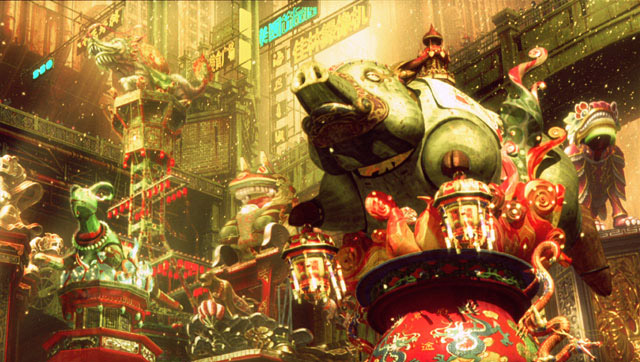
As for the details of the merging of traditional hand drawn animation, there are a few scenes where the Babylon 5-like ships or statues don’t quite fit, but for the most part, the expansive scenes have incredible depth, and the close-ups are as exquisite as a portrait. You are truly missing out on a feat of artistic beauty if pass this movie up. And overall, GITS:2 is clearly in of the best new cyberpunk movies out. Watch it - you won’t be disappointed.
~See movies similar to this one~
Tags: cyberpunk movie review
Year: 1927
Directed by: Fritz Lang
Written by: Fritz Lang (Script), Thea von Harbou (Novel, Script)
IMDB Reference
Degree of Cyberpunk Visuals: High
Correlation to Cyberpunk Themes: Very High
Key Cast Members:
- Maria (cyborg): Brigitte Helm
- Johhan ‘Joh’ Fredersen: Alfred Abel
- Freder Fredersen: Gustav Fröhlich
Rating: 10 out of 10
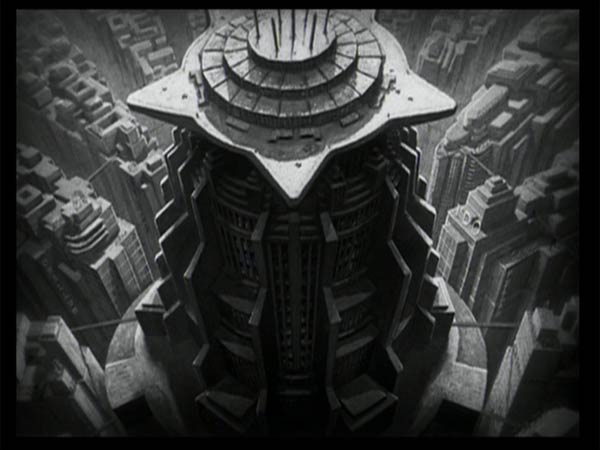
Overview: Most people probably think cyberpunk started in US in the early 80s. I say it started in Germany in 1927. Metropolis all but disapeared after its initial release, but slowly gained a following in drops and drabs, and then with the early 80s restorations, it began to truly take hold in the minds of most as something special in movie making history. Is it a coincidence that Metropolis gained prominence right around the same time as the cyberpunk movement took hold? I think not. If you’re interested in seeing the first movie with replicants, use of computers, cybernetic body parts, full corporate control over society, a robust underground, and a massively negative impact of technology on society, look no further than Fritz Lang’s expressionist masterpiece, Metropolis. You think not? Hopefully my review will sway your opinion.
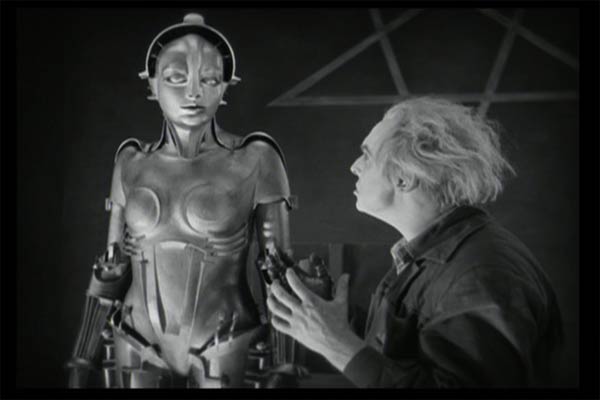
The Story: Metropolis takes place in an extreme dystopic future where a society is clearly divided into the workers and the elite. The elite live above ground in this truly wonderful city called Metropolis that has gardens, fascinating architectures, advanced transport systems and sinful night clubs. The workers live underground, in a dreary non-distinct, undifferentiated set of buildings. Their whole existence centers around keeping the machinery going that powers Metropolis.
Johhan Fredersen, the corporate CEO, does not see the workers as people, but instead sees them as no more than specialized parts in his grand, clockwork-like machinery. This point is struck home in that the workers life is organized in 10 hour shifts. They work 10 hours on, than have 10 hours off. In other words, their sense of time is not dictated by night and day as it is in metropolis - they live underground so they rarely if ever see the sun. Their time and life is fully guided by the needs of the machinery - the 20 hour days ensure they are fully disconnected from anything natural.
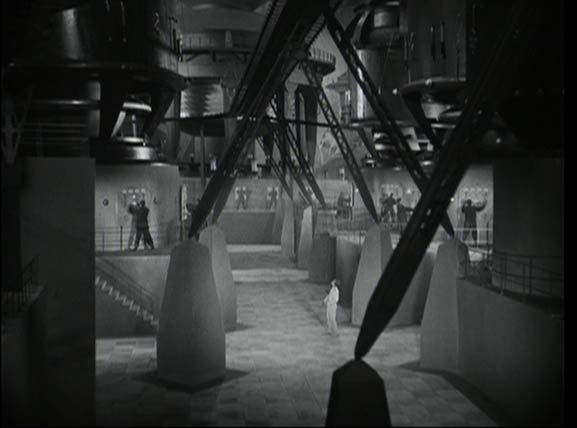
In this world, the son of the corporate CEO (Johhan), Freder, accidentally is exposed to and falls in love with Maria, a woman who has made it her mission to give hope to the working class. Freder takes the role as a working class member and pursues her down to the underground city and takes the role of working class member. While there, he works a grueling 10 hour shift in the factory, and begins to understand the inhumane way they are treated. He later attends a secret meeting in the catacombs where Maria is giving hope to the working class through spreading the word of peace and Christianity.
Unfortunately, Johhan finds out about this worker uniting, and wants to stop it. He does so by enlisting the aid of a mad scientist named C.A. Rotwang. Johhan asks Rotwang to create a replicant of Maria and schemes to replace her in order to incite the workers into revolt so that Johhan can crush the leaders. The story progresses from here, but the short of it involves betrayal, romance, action and suspense.
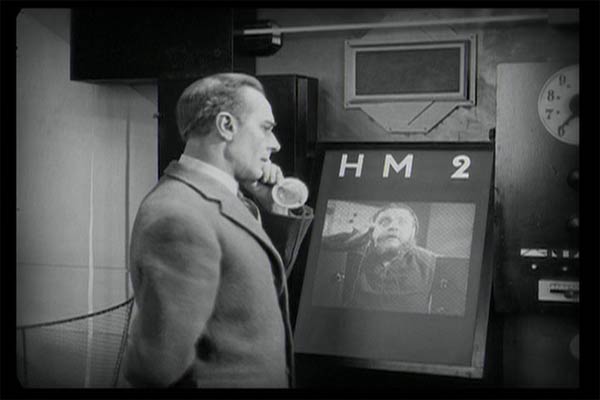
Futuristic Thoughts: While Metropolis was made prior to the computer age, its interesting that the idea of gauges and governors for machines, and a central machine that combines all the inputs and provides it to the executive is already envisioned. A never ending stream of information is sent to a control panel in Johhan’s wall that gives him a constant stock market-like update of the status of the machine. Additionally, Johhan has instant access to anywhere on the job floor by a videophone. In short, Johhan has instant access to the workings of his machine whenever he wants.
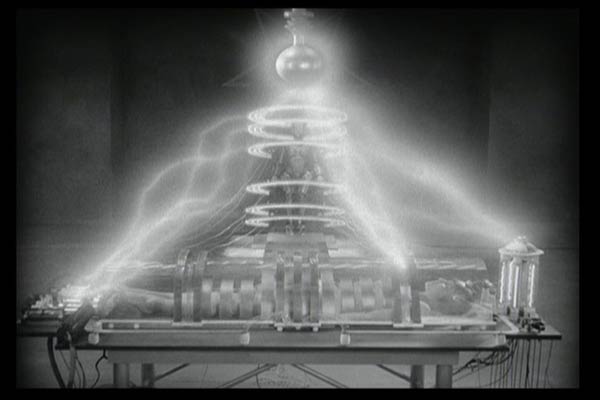
Cyberpunk Visualized: The Replicant C.A. Rotwang modifies to turn into Maria required that the real maria be captured so that her “essence” could be transferred to the robot. By a process unexplained, the robot then has its outside appearance modified to “become” a replicant of Maria. This, in essence, is the precursor to the storyline in Ghost in the Shell: Innocence, where real humans have their ghosts copied and transferred to android dolls. Because Maria’s “ghost” has been replicated into this android, the evil android Maria exudes sexual energy to the point that she instantly enchants the entire worker city and incites them to rebellion.
In this scene above, we see that energy and information are almost synonymous. Maria’s ghosted soul is being transferred into the evil Maria android. And here all this time, I mistakenly thought Frankenstein originated this look! Truly, C.A. Rotwang’s laboratory would have worked perfectly for Dr. Frankenstein.
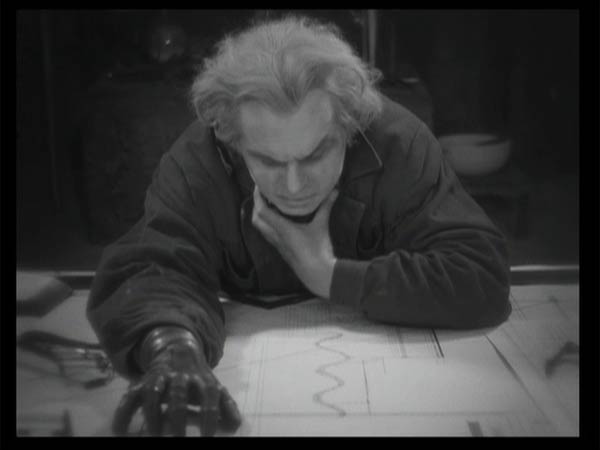
C.A. Rotwang, the evil scientist, has a prosthetic hand that functions as a real hand. He has effectively merged his machinery with the human mind to allow it to function as a part of him. While the word cybernetic body part has not yet been invented yet, the implication is clear - in Metropolis, where machines dominate all aspects of life, it is indeed possible to replace body parts with cyborg limbs.
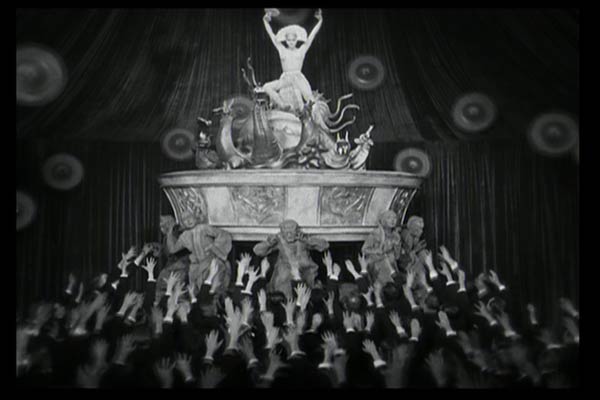
In short, Metropolis portrays a technology-driven culture that devalues and devolves the humanity of the workers, while at the same time, allows the elite to lead perverse and sinful lives. The technology strips us of our humanity both in removing us from a natural existence, integrating us as replaceable parts in a machine, and even allows us to replace people with Replicants!
The Bottom Line: So OK, fine, its possible to look at Metropolis as a cyberpunk film. So why watch it? Answer - because its a terrific movie! If you get the Kino version (you MUST!!! the other cheaper versions don’t follow Lang’s script), you will be viewing a masterpiece of early cinema. Metropolis has replaced Passion of Joan of Arc (Dreyer, 1928) as my favorite silent movie. And truly, its influence on the cyberpunk movie genre is surpassed by only one film. If you get this, you won’t be disapointed.
Page 2: Additional screen captures–>>
Year: 1998
Directed by: Alex Proyas
Written by: Alex Proyas, Lem Dobbs, & David S. Goyer
IMDB Reference
Degree of Cyberpunk Visuals: Very High
Correlation to Cyberpunk Themes: High
Key Cast Members:
John Murdoch: Rufus Sewell
Emma Murdoch/Anna: Jennifer Connelly
Inspector Frank Bumstead: William Hurt
Dr. Daniel Schreber: Kiefer Sutherland
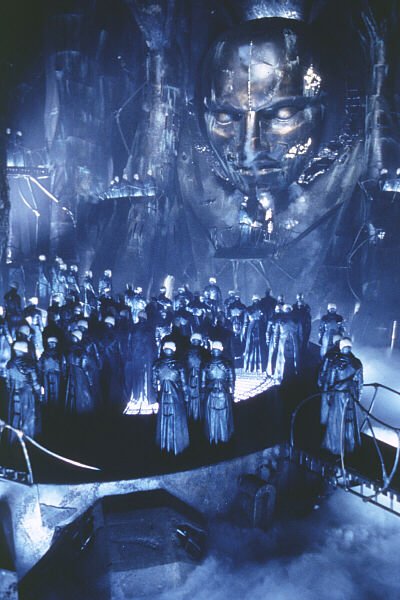
Overview: Dark City was another one of those movies I was on the fence concerning whether it was cyberpunk or not. Yes, it has the visuals in spades, but what about the rest? After watching it again, I decided the answer was an emphatic Yes. Although we don’t really have computers or cyborgs, we certainly have machinery controlling human life - we have invasive and negative impacting technology, an underground, and truly, the strangers have ubiquitous accces to information. Also, Dark City fully exploits cyberpunk’s film noir roots.
But what really sold me was the whole focus on transforming the memories to get at the root of what humanity is. These strangers, or aliens, if you will, are engaging in virtually the same excersize we see from cyborgs in many a cyberpunk film - they want to understand humanity for the expressed purpose of being, or at least acting human.
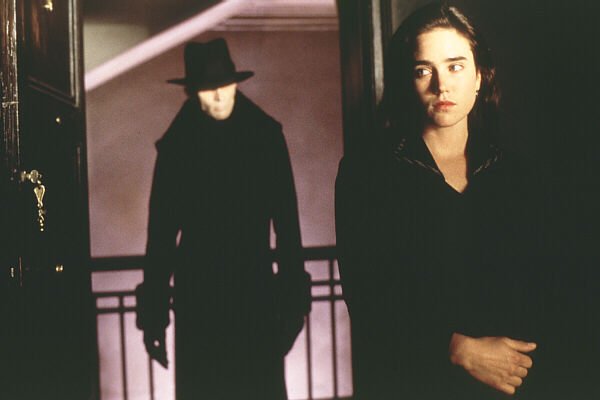
And WOW! What a great film this is. I end up watching Dark City at least once or twice a year, and always end up loving it all over again! This film has awesome style, great acting, terrific suspense and truly interesting and deep ideas!
~See movies similar to this one~
Tags: cyberpunk movie review
Year: 2002
Directed by: Katsuhito Akiyama
Written by: Naoko Hasegawa, Hideki Kakinuma
IMDB Reference
Degree of Cyberpunk Visuals: High
Correlation to Cyberpunk Themes: Medium
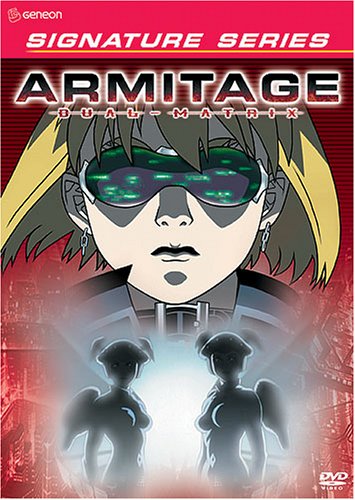 Overview:
Overview: While the budget for the animation is better than the original Armitage, the story is SIGNIFICANTLY worse. The place where Armitage III shines (identification with the characters) is exactly where the sequel is most lacking. They ramp up the cool explosions and fights while substituting mannequins for the lead characters. This was a sequel without a story - the message had already been communicated in the first one, and now there’s nothing left to do but rehash it, only with more incoherently and with more explosions. And really, I find the animation style in the first one lots better, especially for Armitage.
However, the two hot Armitage replicants in wings and skin-tight clothes are pretty cool. In fact, they were definitely the highlight of the movie for me.
Also, as an unintended plus (or minus, really), if you check out the English track, you get to hear the voice of Jar Jar Binks (Ahmed Best) reprise his famous role as a side-kick. Only this time he’s a cyborg doctor (but still sounds the same).
~See movies similar to this one~
Tags: cyberpunk movie review
WordPress database error: [You have an error in your SQL syntax; check the manual that corresponds to your MySQL server version for the right syntax to use near '' at line 1]
SELECT COUNT(ID) FROM
|







